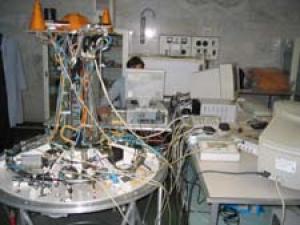The Planetary Society offers an update on its Cosmos 1 solar sail with the announcement that the spacecraft launch date has slipped to April. Planetary Society executive director Louis Friedman said all flight components had been tested and a full-mission sequence simulated with the spacecraft’s on-board computer. The sails are not yet attached to the spacecraft, but will be folded for attachment within the next two weeks. Cosmos 1 will then undergo vacuum chamber testing to check for leaks in its compressed air and fuel lines before being shipped to the launch area. Launch will be aboard a Volna rocket from a Delta III Russian submarine in the Barents Sea.
“There is no way to simulate or adequately test how a sail, which is 30 meters long and 5-millionths of a meter thick, will behave under weightless conditions in a vacuum,” writes Friedman. “It could oscillate, bounce around and even rip apart. Or it could spread wide and sail effortlessly on beams of light as we hope it will. Our team has conducted many, many ground tests – but ultimately, the only test that counts will be the actual flight.”
 Image: Moscow, NPO Lavochkin, December 2004: The flight electronics are tested. A framework that exactly duplicates the size and shape of Cosmos 1 allows access to all the electronic equipment while they are tested in the same relative positions they will occupy in the spacecraft. On the lower level are most of the electronics boxes, notably the flight computer and the radios. In the lower center area the 3-axis micro-accelerometer can be seen. On the top structure are placed several antennas, two small solar panels (for backup power) and the energetic particle analyzer instrument. Credit: The Planetary Society (c)
Image: Moscow, NPO Lavochkin, December 2004: The flight electronics are tested. A framework that exactly duplicates the size and shape of Cosmos 1 allows access to all the electronic equipment while they are tested in the same relative positions they will occupy in the spacecraft. On the lower level are most of the electronics boxes, notably the flight computer and the radios. In the lower center area the 3-axis micro-accelerometer can be seen. On the top structure are placed several antennas, two small solar panels (for backup power) and the energetic particle analyzer instrument. Credit: The Planetary Society (c)
And elsewhere, Space technology: Setting sail for history is a good backgrounder by Tony Reichhardt on the Cosmos 1 mission and Louis Friedman’s role in it. It includes this interesting bit about NASA’s own work on solar sails:
Although no solar-sail missions have yet been approved, [Tim] Van Sant [of NASA’s Goddard Space Flight Center in Maryland] is spending about $10 million a year laying the technological groundwork. This year two pioneers of solar-sail development, L’Garde of Tustin, California, and ABLE Engineering of Goleta, California, will test different designs for 20-m sails in a giant vacuum chamber at NASA’s Plum Brook facility in Ohio.
ABLE’s sail is made of an extremely thin new polymer called CP-1, only 2.5 micrometres thick — half as thick as the aluminized Mylar on Cosmos 1. “If you sneeze, you’ll send this stuff across the table,” says Van Sant. Thinner and lighter is better when it comes to solar sails, but flimsy films are also more prone to tearing. Even the reinforced sails of Cosmos 1 won’t last forever: within a month of launch they will begin to degrade in the harsh sunlight. But the short flight should be long enough to demonstrate the principle of solar sailing, and if successful will open the heavens to other solar-powered craft.

